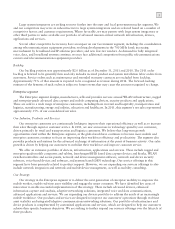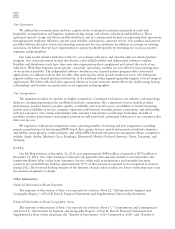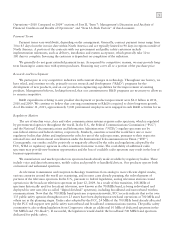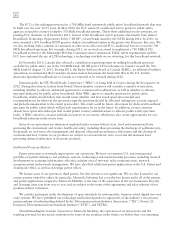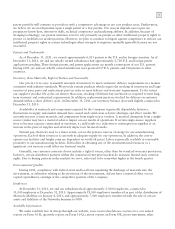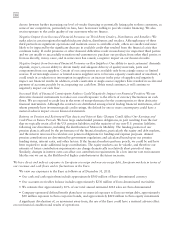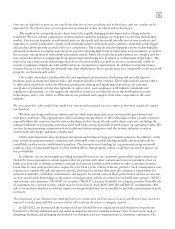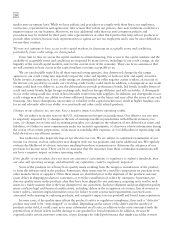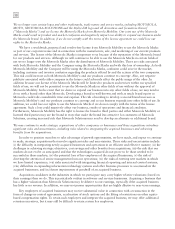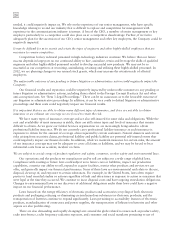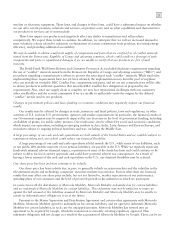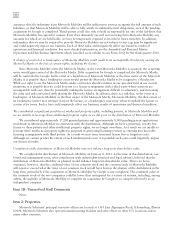Motorola 2011 Annual Report Download - page 19
Download and view the complete annual report
Please find page 19 of the 2011 Motorola annual report below. You can navigate through the pages in the report by either clicking on the pages listed below, or by using the keyword search tool below to find specific information within the annual report.
13
the access to allocated spectrum for public safety users, (ii) if adequate frequencies are not allocated, or (iii) if new
technologies are not developed to better utilize the frequencies currently allocated for such use. Industry growth may
also be affected by new licensing fees required to use frequencies.
The U.S. leads the world in spectrum deregulation, allowing new wireless communications technologies to be
developed and offered for sale. Examples include wireless local area network systems, such as WiFi, mesh
technologies and wide area network systems, such as WiMAX and LTE. Other countries have also deregulated
portions of their available spectrum to allow deployment of these and other technologies. Deregulation may
introduce new competition and new opportunities for us.
The U.S. is currently contemplating allocating the 10 MHz in the 700 MHz spectrum “D block” to public
safety. Alternatively the D block spectrum may be auctioned to commercial carriers, as has been advocated by the
Federal Communications Commission (“FCC”). Failure to allocate the D block spectrum to public safety could
reduce sales of next generation public safety communications systems in the U.S. and, as a result, could negatively
impact our business. Even if D block legislation passes, there remains a risk that some provisions of the legislation
may limit our ability to compete for LTE business and could also limit future narrowband sales if the legislation
requires public safety to give back narrowband spectrum in the 700 MHz spectrum block.
Our customers and suppliers are located throughout the world and, as a result, we face risks that other companies
that are not global may not face.
Our customers and suppliers are located throughout the world and more than 40% of our revenue is generated
by customers outside the U.S. In addition, we have a number of manufacturing, research and development,
administrative and sales facilities outside the U.S. and more than 50% of our employees are employed outside the
U.S. Most of our suppliers’ operations are outside the U.S. and most of our products are manufactured outside the
U.S.
As with all companies that have sizeable sales and operations outside the U.S., we are exposed to risks that
could negatively impact sales or profitability, including but not limited to: (i) import/export regulations, tariffs,
trade barriers and trade disputes, customs classifications and certifications, including but not limited to changes in
classifications or errors or omissions related to such classifications and certifications; (ii) changes in U.S. and
non-U.S. rules related to trade, environmental, health and safety, technical standards and consumer protection;
(iii) longer payment cycles; (iv) tax issues, such as tax law changes, variations in tax laws from country to country
and as compared to the U.S., obligations under tax incentive agreements, difficulties in repatriating cash generated
or held abroad in a tax-efficient manner and difficulties in securing local country approvals for cash repatriations;
(v) currency fluctuations, particularly in the euro, Chinese renminbi, the British pound, Japanese yen, Malaysian
ringgit and the Brazilian real among others; (vi) foreign exchange regulations, which may limit our ability to convert
or repatriate foreign currency; (vii) challenges in collecting accounts receivable; (viii) cultural and language
differences; (ix) employment regulations and local labor conditions; (x) difficulties protecting intellectual property in
foreign countries; (xi) instability in economic or political conditions, including inflation, recession and actual or
anticipated military or political conflicts; (xii) natural disasters such as the recent earthquake and tsunami in Japan
and floods in Thailand; (xiii) public health issues or outbreaks; (xiv) changes in laws or regulations that negatively
impact benefits being received by us or that require costly modifications in products sold or operations performed in
such countries; (xv) the impact of each of the foregoing on our outsourcing and procurement arrangements; and
(xvi) litigation in foreign court systems and foreign administrative proceedings.
Many of our products that are manufactured outside the U.S. are manufactured in Asia (primarily Malaysia
and China) and Latin America (primarily Mexico). If manufacturing in these regions is disrupted, our overall
capacity could be significantly reduced and sales or profitability could be negatively impacted. Furthermore, the
legal system in China is still developing and this and other legal systems around the world are subject to change.
Accordingly, our operations and orders for products in China could be negatively impacted by changes to, or
interpretation of, Chinese law.
We also have a presence in emerging markets such as India. We face additional challenges in emerging markets,
including creating demand for our products and the negative impact of changes in the laws or the interpretation of
the laws, in those countries.
We also are subject to risks that our operations could be conducted by our employees, contractors,
representatives or agents in ways that violate the Foreign Corrupt Practices Act, the U.K. Anti-Bribery Act, or other


